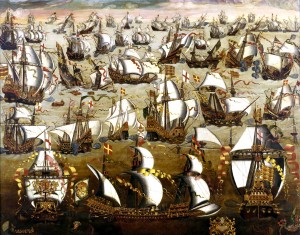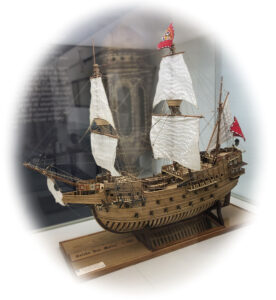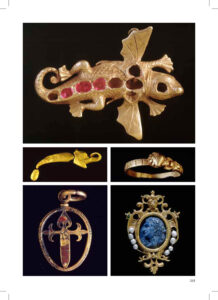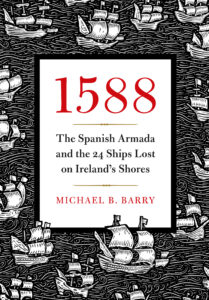The Spanish Armada: Myths and Misconceptions

By Michael Barry
The Spanish Armada was a hugely important event in world history. In this article I begin by giving a summary of the Armada story, from beginning to end.
Next, I will focus on some new information, which dispels some long-standing myths about the Armada. One of the reasons for this has been that to date the historiography on this topic has been dominated by British sources – there have literally been an armada of such books in the last 50 years.
This has resulted in a certain group-think that tends to emphasise the perceived superior performance of the English Navy and their ships. In the course of my research for this book, I endeavoured to go beyond this. Fortuitously, I managed to find new evidence and facts, fruits of a vigorous flourishing of Spanish historians who have, over recent decades, investigated the Anglo-Spanish War (1585-1604) and have presented new material.
One seminal publication has been the monumental La Batalla del Mar Océano, prepared by the Spanish Ministry of Defence and containing practically all contemporary documents on the Armada, from all sources[1]. This has allowed me to take a more balanced approach and permitted me to dispel some common myths about the Armada that still prevail today.
-
THE ARMADA STORY
The Enterprise of England

The intention of Philip II of Spain, in his so-called ‘Enterprise of England’, had been to invade England and depose Elizabeth I, replacing her with a Catholic (and Spanish-friendly) ruler.
It hadn’t always been thus. In 1554, Philip had married Queen Mary of England, a time of friendship between Spain and England. After Mary’s death in 1558 a reluctant Philip made a desultory offer to marry her half-sister, an equally reluctant Elizabeth. In the meantime a rebellion by Protestants grew and gained momentum in the Spanish Netherlands.
After Elizabeth ascended to the throne, she maintained the Protestantism of her father and, in 1570, an exasperated Pope excommunicated her. By 1580 relations between England and Spain were at a low ebb and after Philip inherited the Portuguese throne, Elizabeth supported the pretender Dom António. The Queen agreed in 1585 to send a large force to support the Dutch rebels.
Phillip II planned to invade England in response to their military aid to the Dutch rebels and raids on Spanish shipping.
This was a step too far: Philip judged the Low Countries to be the jewel in the crown of his empire. Later that year Francis Drake began his attack on Northern Spain and went on to rampage across the Caribbean. In February 1587 Mary, Queen of Scots, was executed. With relations between Spain and England in terminal decline, the journey to war was now inevitable.
The constant English attacks on Spanish treasure fleets proved too much and the concept of an invasion of England came under intense discussion. In 1585, a new, energetic Pope, Sixtus V, urged Philip to help eradicate heresy in England. English piracy continued to be on the increase and Drake was to the fore.
On the basis that it was more effective to strike at the heart of the English enemy than to set in place defensive forces across his vast Spanish Empire, Philip asked his advisors and commanders for invasion plans. With English troops arriving in the Netherlands to help the rebels in 1585, preliminary work began in Lisbon on assembling a fleet, an army, and the equipment necessary for an invasion of England.
As England endeavoured to make ready its army, and navy, the Duke of Parma, in charge in the Spanish Netherlands, was assembling his tercios on the Flanders coast. After the death of the admiral assigned to lead the Armada, the Marquis of Santa Cruz in February 1588, his replacement, the Duke of Medina Sidonia, arrived and put more order on the Armada preparations in Lisbon.
The Armada sets sail

The Armada, essentially a large armed convoy, set sail at the end of May 1588, destination: at the coast of Margate, to establish a beachhead there, and to protect Parma’s men in their invasion barges as they sailed from Flanders[2].
As they sailed north, storms ensued, and with many provisions turned sour, the Armada had to stop at Corunna. On 22 July, the fleet of 128 ships, now re-provisioned, set out for the English Channel.
As the Armada sailed along off the southern English coast there was a series of attacks by the English fleet but they did not manage to pierce the strong defensive formation ordered by Medina Sidonia. On 6 August, as the Armada anchored at Calais, it was soon discovered that Parma was not ready with his invasion barges. When the English sent in fireships the following night, the fleet scattered. The following day, 8 August, the long and bloody Battle of Gravelines ensued. Most of the Spanish fleet was scattered over 20km – crucially the Armada had lost its defensive formation.
While the Spanish fleet was bloodied by the English off the Gravelines, only one Spanish ship was sunk.
Medina Sidonia and a small number of galleons (initially less than 10) formed a rearguard, as the English ships swarmed in, blasting away repeatedly. Spanish casualties were high that day – there were an estimated 800 fatalities. While many Spanish ships were damaged and two galleons ran aground on the Dutch coast, despite the expenditure of practically all their powder and shot, the English ships managed to directly sink just one ship.
In the aftermath, the Armada regained its defensives formation and the English fleet stood off. It was decided after a council of war, the following day, that if the wind continued from the south, the fleet would take the long journey north around Scotland and Ireland to return to Spain – and the wind continued from the south.
The fatal Irish shores

Continuous storms beset them as they sailed around Scotland and west into the Atlantic. Many ships lost sight of the flagship and were driven towards the dangerous coasts of Scotland and Ireland. Finally on 21 September, the Armada flagship, leading a small number of ships, arrived off Santander. In the weeks that followed other Armada vessels returned to the ports of northern Spain.
The exceptional stormy weather caused shipwrecks, mainly along the Atlantic coast of Ireland where 24 Armada vessels met their end[3].
The hardship did not end there: the English authorities in Ireland, with just a small army on Irish soil, ordered the execution of all Spaniards.
This resulted in the slaughter of around 1,500 survivors by English soldiers or their Irish proxies[4]. The fate of the many that were killed, and of the few lucky few officers who were ransomed has been told in a recently published book by Pedro Chinchilla[5].
-
MANY MYTHS
There was an understandable boost to English morale after it became evident that the immediate Spanish threat had been overcome. Services were held all over England giving thanks.
The failure of the Armada was presented as an overwhelming defeat by plucky (and Protestant) England over a despotic Catholic Spain
In the aftermath, there was much exaggeration and dissimulation. Back in 1588, Dutch Protestants in the Netherlands rejoiced just as much as their English coreligionists at the defeat of their common enemy. A set of commemorative medals struck there pointed out whose side God was on, implying that in effect it was a Protestant wind that had confounded the Spanish fleet. One medal depicted a fleet on a stormy sea with the Latin inscription Flavit et Dissipati Sunt ‘[God] blew and they were scattered’.
The failure of the Armada was presented as an overwhelming defeat by plucky (and Protestant) England over a despotic Catholic Spain, brimming with the fanaticism of the Inquisition, and inflicting cruelties during its colonisation of the Americas. This demonisation of Spain (called the ‘Leyenda Negra’ or ‘Black Legend’ in that country) has continued over the centuries and traces persist to this day in the Anglophone world. In the following passages, I discuss some of the other myths that persist
‘The Black Irish’
This is a myth, peculiar to Ireland. It tells about the ‘Black Irish’, the black-haired Irish supposedly descended from Armada survivors. It is not true – the survivors were slaughtered or, if they were lucky enough to evade capture, concentrated on trying to gain passage to Scotland. There are other reasons: the centuries of Spanish fishing along the Irish coasts, as well as the trade between to two countries. In addition, genetic studies in Trinity College Dublin indicate that Ireland was settled by migrants from northern Spain after the last ice age[6].
‘The English fleet destroyed most of the Armada’
 Up to recent times the perception in Britain has been that the Armada events were a glorious triumph, with Drake and his navy decisively smashing the Armada fleet. However, the facts had not been allowed to intrude: in reality Elizabeth had just had a lucky escape; just one Spanish ship had been directly sunk by English cannon fire. The rest were mainly lost due to accidents or shipwreck.
Up to recent times the perception in Britain has been that the Armada events were a glorious triumph, with Drake and his navy decisively smashing the Armada fleet. However, the facts had not been allowed to intrude: in reality Elizabeth had just had a lucky escape; just one Spanish ship had been directly sunk by English cannon fire. The rest were mainly lost due to accidents or shipwreck.
Of the Armada muster of ships that departed from Corunna, 128 vessels, the most up-to-date estimate is that 91 ships eventually made it back to northern Spanish ports. It is a tribute to the captains and sailors mariners, and importantly, to the solid build of Spanish and Portuguese ships, that over two thirds of the fleet managed to return to Spain after encountering such horrendous challenges.
It is worth noting that the following year, an English counter-Armada sailed out to attack Iberian targets. It comprised over 180 ships, some veterans of the Channel encounters with the Armada. It is difficult to estimate the loss of ships, as some of the Dutch flyboats returned home and there are few meticulous records of the English ships, unlike those kept in Spain relating to their fleet. One estimate puts the English losses at 70 ships which, if correct, is around 39 per cent – a significantly higher rate of attrition than the 29 per cent losses of the Spanish Armada of the previous year[7].
‘The English had better ships ‘

Spain was the maritime superpower, with strong ships that were able to sail across the Atlantic. Spanish shipbuilding had flourished during the sixteenth century, particularly along the Cantabrian coast. The galleons were constructed to the specifications of the Crown – Philip had previously called together the most prominent experts to establish the optimum design of warships.
Many seminal books were written in Spain on navigation, ship construction and naval tactics. As the shipbuilding programmes progressed, there was a gradual evolution: the ships became progressively larger and with a greater length in relation to the beam, resulting in faster speeds.
Accounts say that the move to develop faster warships was part of a general western European trend, from Denmark down to Spain. Irrespective of who was the source, the general tendency then was to lengthen ships and reduce the height of the traditional ship castles at front and back.
Equally, in England, the privateer John Hawkins, appointed Treasurer of the Navy in 1578, is credited with improvements in English naval construction., In contrast with some ships of the existing Navy Royal, most of the new build of ships were smaller, in the range 400-500 tons. The designs, in line with the general trend, were with the castles fore and aft being lower. These relatively smaller ships were armed with a range of heavy guns, arranged on several gun decks.
It was under Hawkin’s watch that the English navy had been transformed into a force suitable for a defensive war operating in coastal waters. The English ships were not ideal for long-distance cruising as they were crowded and their limited hold space could not accommodate much food and supplies. Their ships’ abilities were suited to the way the battles turned out in the English Channel and off Gravelines, just a short distance from home ports – although when they were following the Armada up the North Sea, they ran out of victuals after reaching the Firth of Forth.
‘The English had better gunnery’
Over the course of the battles along the Channel and at Gravelines, some eyewitnesses estimated that the English gunners were able to discharge guns at several times the rate of their Spanish counterparts. Much has been made of the presumed disadvantage arising from moving around the two-wheeled Spanish gun carriages – with a supposed lesser rate of fire. By contrast the English used shorter four-wheeled gun-carriages.
However, the historian Gómez Beltrán[8], using a cross-sectional diagram, has shown that there was ample space to manoeuvre these on the gun decks of large galleons, even though the Spanish gun-carriages were around 90cm longer than the English equivalent.
The problem of overheating is thought to have been the underlying cause for the lesser rate of Spanish fire. Guns of that era overheated after sustained action – the effect of overheating on a brass gun is that it would begin to deform. The gunners could assess the condition of their gun and would desist from firing, probably after three or so shots. Remedies included waiting for the gun to cool down, or covering the gun with wet blankets or sheepskins.
This phenomenon affected the Spanish gun crews, particularly on the fateful day of Monday August 8, in that most important encounter off Gravelines – during that fierce battle which raged for around eight hours. After the fireship scare, the Armada had fallen out of its defensive formation, and was scattered. The English squadrons fell upon the rearguard, led by Medina Sidonia in the San Martín, and had the advantage.
Groups of their ships were able to target an isolated vessel and then swoop in. The English fleet came into their own at the battle of Gravelines. With little victuals and stores on board, they were higher in the water than the laden Armada ships, and were able to sail with agility, when they clustered around the by now isolated Spanish rearguard.
With odds of ten to one, they clustered around individual Spanish ships and let off their broadsides. The gunner on any Spanish ship at the centre of the vortex could only discharge at a measured rate, due to concerns about heating of the gun. The gunners amidst the English ships, adopting their whirling dervish tactics, had the convenience of an interval, before their ship lined up gain.
The corollary to the pounding that the Armada ships received is that the Spanish warships were well built and able to absorb considerable punishment. Timber such as oak from the Cantabrian Mountains, well-developed designs, along with excellent shipwrights, resulted in robust Spanish vessels – the galleons and naos were in effect, floating bastions. Despite much expenditure of powder and shot, the English found it difficult to directly sink a Spanish ship.
-
A CLOSE CALL

It was a close call for England. The crucial point in the Armada expedition was when the fleet had anchored off of Calais. The Duke of Parma and his Army of Flanders were scarcely more than 35km away. However, the implied presence of the Dutch fleet had induced fear in Parma and ensured that the Dutch, without firing a shot, managed to kill off the crucial element of the Armada plan, that of sailing on to invade England.
If Parma, with an experienced naval commander at his side, had ventured forth in accordance with established Spanish protective naval doctrine, with the aim of rendezvousing with Medina Sidonia’s fleet, in position offshore, things could have been radically different.
If Medina Sidonia had assigned the shallower-draughted and well-gunned vessels, namely the galleasses, smaller galleons, naos and larger pataches, to sail as close to the harbour approaches as possible, it would have been unlikely that the Dutch navy would have been able to dart along the coast and interdict Parma’s barges.
 Once these barges were corralled within the lines of the iron-disciplined Armada, they all could have made sail for Margate. Once landed, these tercios, the best troops in Europe, would have been at the gates of London, within a week. A Catholic ruler, sympathetic to Spain would have been installed. In the colony next door, Ireland, it was probable that a Catholic ruler, oriented of course towards Spain, would have also been installed.
Once these barges were corralled within the lines of the iron-disciplined Armada, they all could have made sail for Margate. Once landed, these tercios, the best troops in Europe, would have been at the gates of London, within a week. A Catholic ruler, sympathetic to Spain would have been installed. In the colony next door, Ireland, it was probable that a Catholic ruler, oriented of course towards Spain, would have also been installed.
As in Philp’s European domain’s, the local languages (English and Irish, respectively) would have been allowed to continue. However, the chances are that the Spanish would have rolled on with their conquest of North America and quite possibly Español would have become the international language in the Western world.
However, this scenario has to remain hypothetical, because, with the advent of the fireships at Calais and the resulting shattering of the Armada formation, this fireship manoeuvre on the night of 7 August became the pivotal moment after which the Enterprise of England was to meet with failure.
Michael Barry is the author of ‘1588, the Spanish Armada and the 24 ships lost on Ireland’s Shores’, hardback, Andalus Press, 2024
![]()
References
[1] Various ed., La Batalla del Mar Océano (Vols. 1 to 5), Ministerio de Defensa – Armada Española, Madrid, 2015. (available free online)
[2] Martin, C., Parker, P., Armada, Yale University Press, London, 2022. A comprehensive history of the Armada
[3] Douglas, K., The Downfall of the Spanish Armada in Ireland, Gill & Macmillan, Dublin, 2010.
[4] Fallon, N., The Armada in Ireland, Wesleyan University Press, Connecticut, 1978.
[5] Chinchilla, P., Los Prisioneros de La Armada Invencible, Ediciones B, Barcelona, 2023.
[6] https://www.irishtimes.com/news/genetic-studies-show-our-closest-relatives-are-found-in-galicia-and-the-basque-region
[7] Gorrochategui Santos, L., The English Armada, the Greatest Naval Disaster in English History, Bloomsbury, London, 2018.
[8] Gómez Beltrán, A., La Invencible y su Leyenda Negra, Del Fracasa Inglés en la ‘Derrota’ de la Armada Española, Arin Ediciones, Benalmádena, 2013.